light JEEP GRAND CHEROKEE 2010 Owner handbook (in English)
[x] Cancel search | Manufacturer: JEEP, Model Year: 2010, Model line: GRAND CHEROKEE, Model: JEEP GRAND CHEROKEE 2010Pages: 350, PDF Size: 4.58 MB
Page 110 of 350
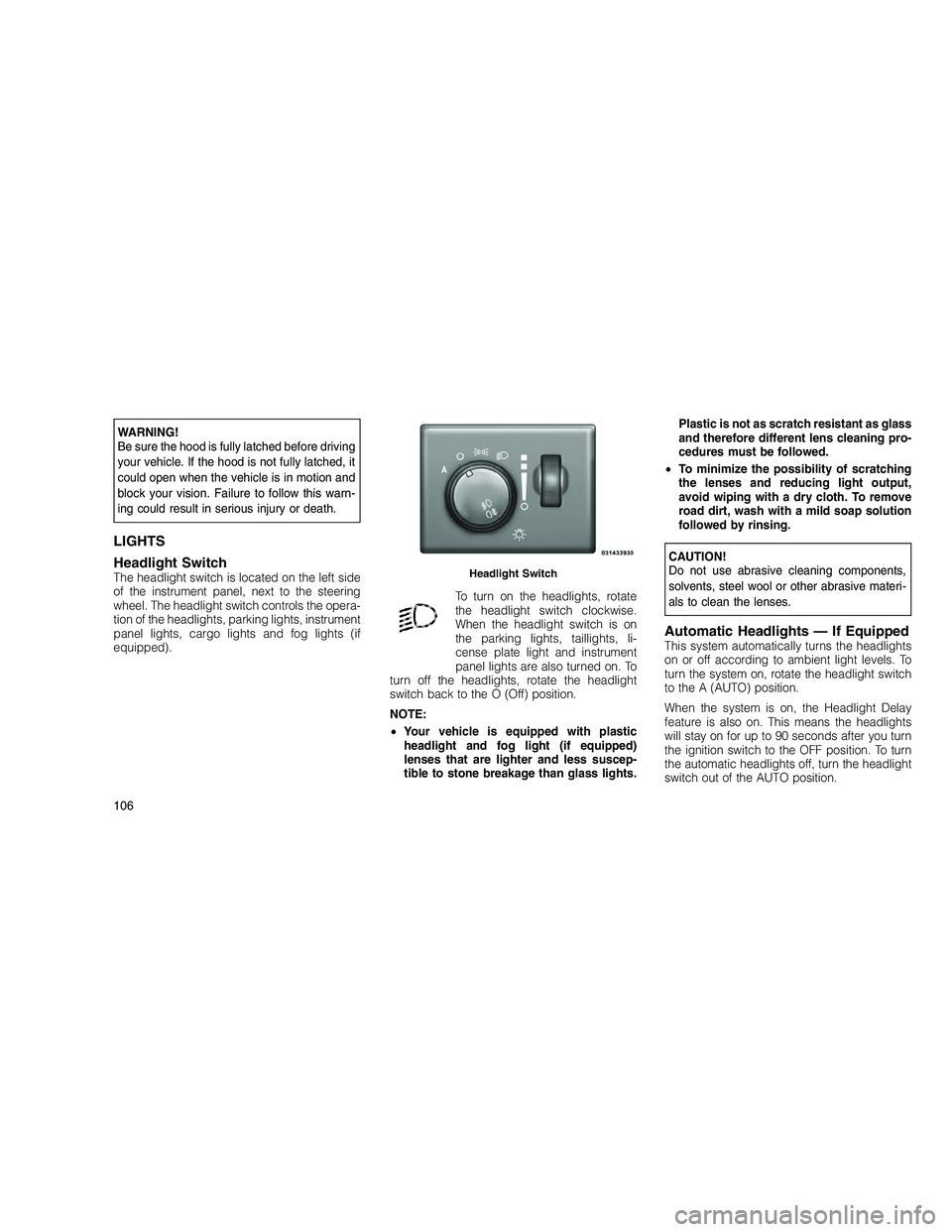
WARNING!
Be sure the hood is fully latched before driving
your vehicle. If the hood is not fully latched, it
could open when the vehicle is in motion and
block your vision. Failure to follow this warn-
ing could result in serious injury or death.
LIGHTS
Headlight Switch
The headlight switch is located on the left side
of the instrument panel, next to the steering
wheel. The headlight switch controls the opera-
tion of the headlights, parking lights, instrument
panel lights, cargo lights and fog lights (if
equipped).To turn on the headlights, rotate
the headlight switch clockwise.
When the headlight switch is on
the parking lights, taillights, li-
cense plate light and instrument
panel lights are also turned on. To
turn off the headlights, rotate the headlight
switch back to the O (Off) position.
NOTE:
• Your vehicle is equipped with plastic
headlight and fog light (if equipped)
lenses that are lighter and less suscep-
tible to stone breakage than glass lights. Plastic is not as scratch resistant as glass
and therefore different lens cleaning pro-
cedures must be followed.
• To minimize the possibility of scratching
the lenses and reducing light output,
avoid wiping with a dry cloth. To remove
road dirt, wash with a mild soap solution
followed by rinsing.
CAUTION!
Do not use abrasive cleaning components,
solvents, steel wool or other abrasive materi-
als to clean the lenses.
Automatic Headlights — If EquippedThis system automatically turns the headlights
on or off according to ambient light levels. To
turn the system on, rotate the headlight switch
to the A (AUTO) position.
When the system is on, the Headlight Delay
feature is also on. This means the headlights
will stay on for up to 90 seconds after you turn
the ignition switch to the OFF position. To turn
the automatic headlights off, turn the headlight
switch out of the AUTO position.
Headlight Switch
106
Page 111 of 350
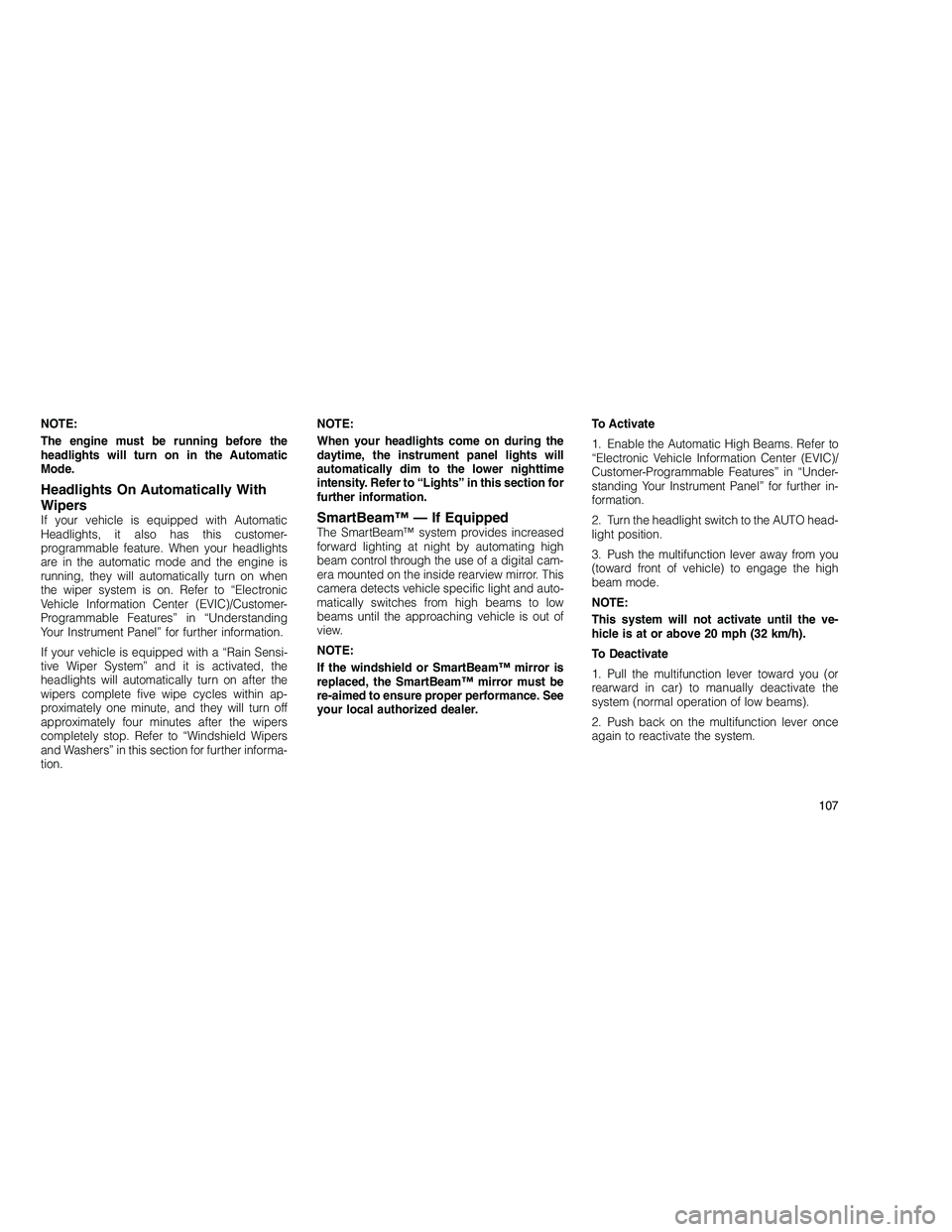
NOTE:
The engine must be running before the
headlights will turn on in the Automatic
Mode.
Headlights On Automatically With
Wipers
If your vehicle is equipped with Automatic
Headlights, it also has this customer-
programmable feature. When your headlights
are in the automatic mode and the engine is
running, they will automatically turn on when
the wiper system is on. Refer to “Electronic
Vehicle Information Center (EVIC)/Customer-
Programmable Features” in “Understanding
Your Instrument Panel” for further information.
If your vehicle is equipped with a “Rain Sensi-
tive Wiper System” and it is activated, the
headlights will automatically turn on after the
wipers complete five wipe cycles within ap-
proximately one minute, and they will turn off
approximately four minutes after the wipers
completely stop. Refer to “Windshield Wipers
and Washers” in this section for further informa-
tion.NOTE:
When your headlights come on during the
daytime, the instrument panel lights will
automatically dim to the lower nighttime
intensity. Refer to “Lights” in this section for
further information.SmartBeam™ — If EquippedThe SmartBeam™ system provides increased
forward lighting at night by automating high
beam control through the use of a digital cam-
era mounted on the inside rearview mirror. This
camera detects vehicle specific light and auto-
matically switches from high beams to low
beams until the approaching vehicle is out of
view.
NOTE:
If the windshield or SmartBeam™ mirror is
replaced, the SmartBeam™ mirror must be
re-aimed to ensure proper performance. See
your local authorized dealer.
To Activate
1. Enable the Automatic High Beams. Refer to
“Electronic Vehicle Information Center (EVIC)/
Customer-Programmable Features” in “Under-
standing Your Instrument Panel” for further in-
formation.
2. Turn the headlight switch to the AUTO head-
light position.
3. Push the multifunction lever away from you
(toward front of vehicle) to engage the high
beam mode.
NOTE:
This system will not activate until the ve-
hicle is at or above 20 mph (32 km/h).
To Deactivate
1. Pull the multifunction lever toward you (or
rearward in car) to manually deactivate the
system (normal operation of low beams).
2. Push back on the multifunction lever once
again to reactivate the system.
107
Page 112 of 350
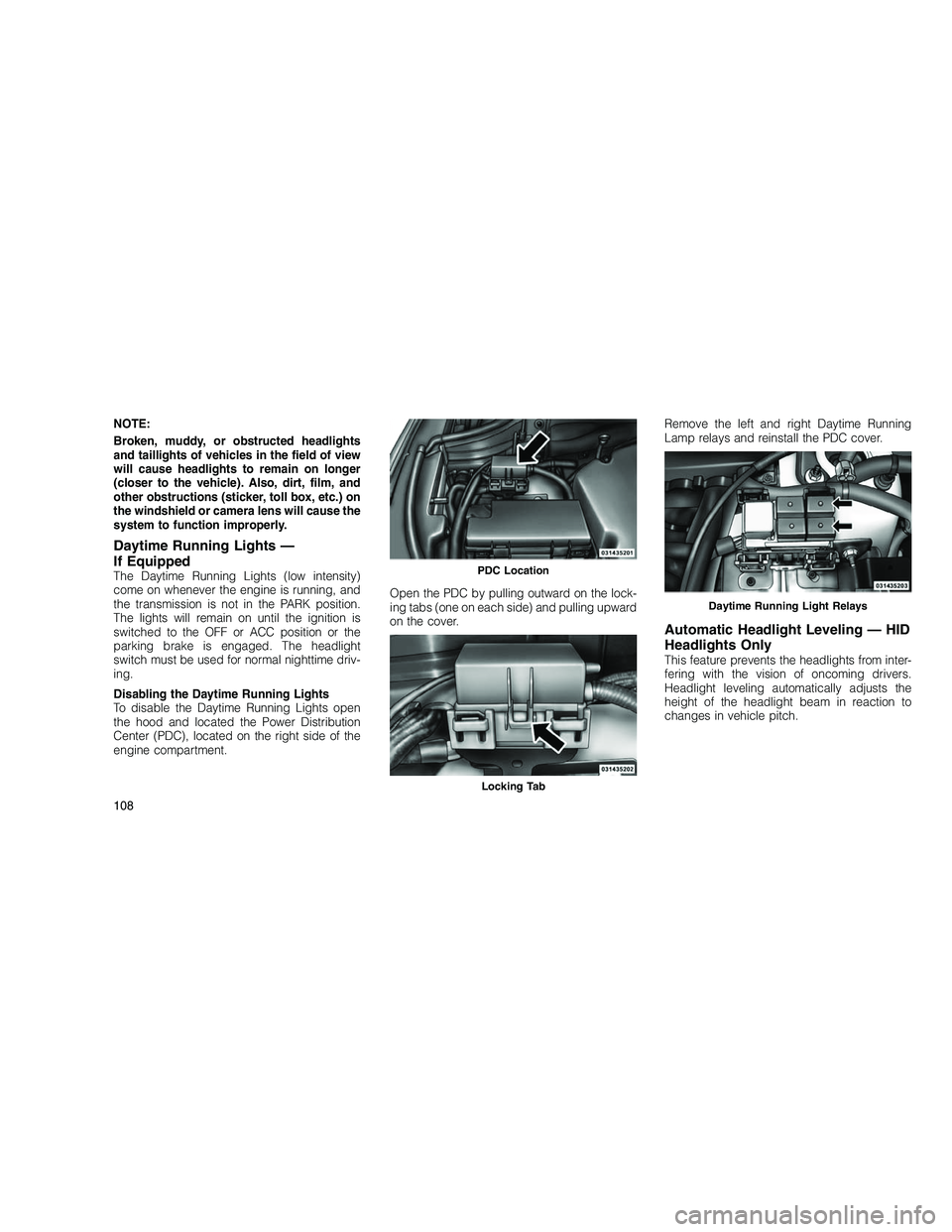
NOTE:
Broken, muddy, or obstructed headlights
and taillights of vehicles in the field of view
will cause headlights to remain on longer
(closer to the vehicle). Also, dirt, film, and
other obstructions (sticker, toll box, etc.) on
the windshield or camera lens will cause the
system to function improperly.
Daytime Running Lights —
If Equipped
The Daytime Running Lights (low intensity)
come on whenever the engine is running, and
the transmission is not in the PARK position.
The lights will remain on until the ignition is
switched to the OFF or ACC position or the
parking brake is engaged. The headlight
switch must be used for normal nighttime driv-
ing.
Disabling the Daytime Running Lights
To disable the Daytime Running Lights open
the hood and located the Power Distribution
Center (PDC), located on the right side of the
engine compartment.Open the PDC by pulling outward on the lock-
ing tabs (one on each side) and pulling upward
on the cover.Remove the left and right Daytime Running
Lamp relays and reinstall the PDC cover.
Automatic Headlight Leveling — HID
Headlights Only
This feature prevents the headlights from inter-
fering with the vision of oncoming drivers.
Headlight leveling automatically adjusts the
height of the headlight beam in reaction to
changes in vehicle pitch.
PDC Location
Locking Tab
Daytime Running Light Relays
108
Page 113 of 350
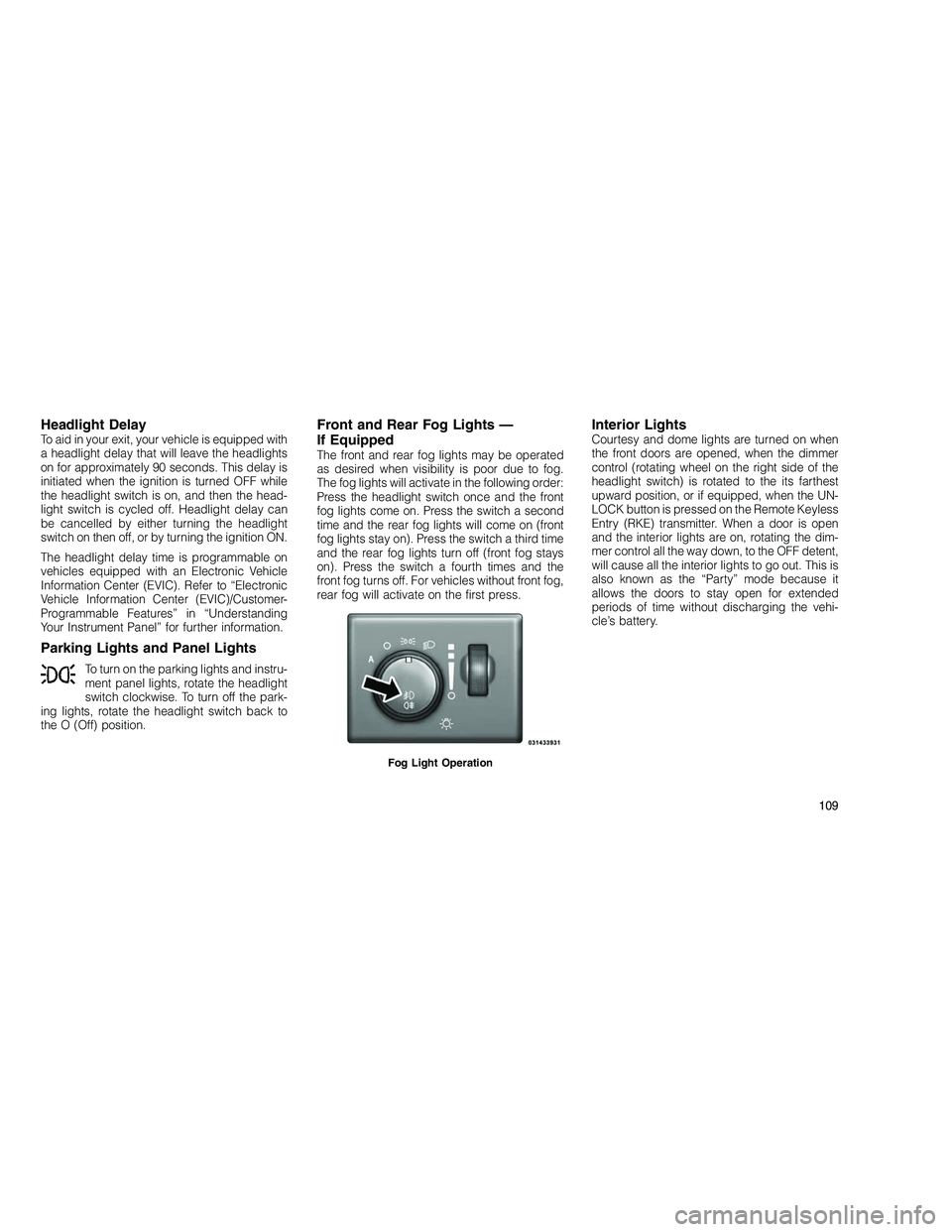
Headlight DelayTo aid in your exit, your vehicle is equipped with
a headlight delay that will leave the headlights
on for approximately 90 seconds. This delay is
initiated when the ignition is turned OFF while
the headlight switch is on, and then the head-
light switch is cycled off. Headlight delay can
be cancelled by either turning the headlight
switch on then off, or by turning the ignition ON.
The headlight delay time is programmable on
vehicles equipped with an Electronic Vehicle
Information Center (EVIC). Refer to “Electronic
Vehicle Information Center (EVIC)/Customer-
Programmable Features” in “Understanding
Your Instrument Panel” for further information.
Parking Lights and Panel Lights
To turn on the parking lights and instru-
ment panel lights, rotate the headlight
switch clockwise. To turn off the park-
ing lights, rotate the headlight switch back to
the O (Off) position.
Front and Rear Fog Lights —
If Equipped
The front and rear fog lights may be operated
as desired when visibility is poor due to fog.
The fog lights will activate in the following order:
Press the headlight switch once and the front
fog lights come on. Press the switch a second
time and the rear fog lights will come on (front
fog lights stay on). Press the switch a third time
and the rear fog lights turn off (front fog stays
on). Press the switch a fourth times and the
front fog turns off. For vehicles without front fog,
rear fog will activate on the first press.
Interior LightsCourtesy and dome lights are turned on when
the front doors are opened, when the dimmer
control (rotating wheel on the right side of the
headlight switch) is rotated to the its farthest
upward position, or if equipped, when the UN-
LOCK button is pressed on the Remote Keyless
Entry (RKE) transmitter. When a door is open
and the interior lights are on, rotating the dim-
mer control all the way down, to the OFF detent,
will cause all the interior lights to go out. This is
also known as the “Party” mode because it
allows the doors to stay open for extended
periods of time without discharging the vehi-
cle’s battery.
Fog Light Operation
109
Page 114 of 350
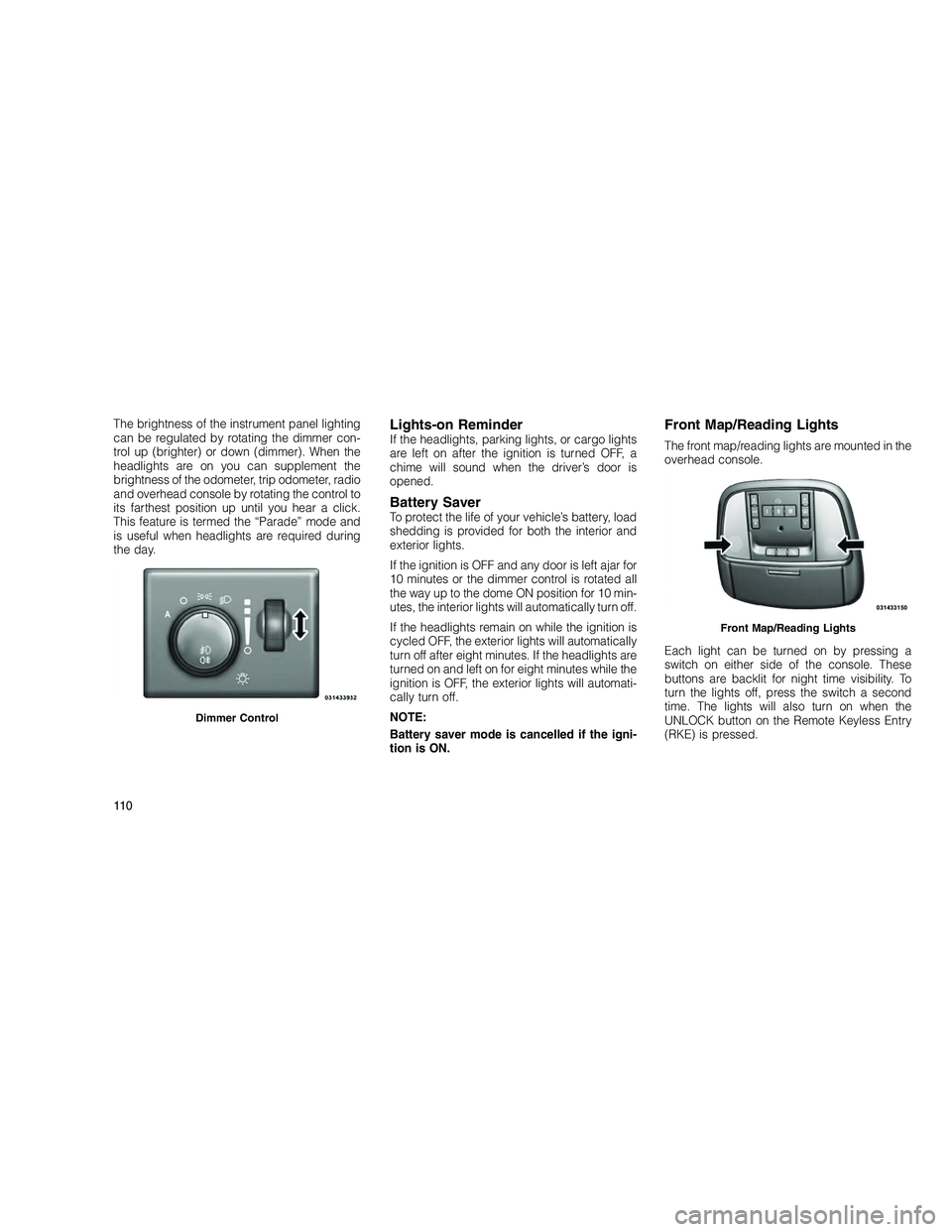
The brightness of the instrument panel lighting
can be regulated by rotating the dimmer con-
trol up (brighter) or down (dimmer). When the
headlights are on you can supplement the
brightness of the odometer, trip odometer, radio
and overhead console by rotating the control to
its farthest position up until you hear a click.
This feature is termed the “Parade” mode and
is useful when headlights are required during
the day.Lights-on ReminderIf the headlights, parking lights, or cargo lights
are left on after the ignition is turned OFF, a
chime will sound when the driver’s door is
opened.
Battery SaverTo protect the life of your vehicle’s battery, load
shedding is provided for both the interior and
exterior lights.
If the ignition is OFF and any door is left ajar for
10 minutes or the dimmer control is rotated all
the way up to the dome ON position for 10 min-
utes, the interior lights will automatically turn off.
If the headlights remain on while the ignition is
cycled OFF, the exterior lights will automatically
turn off after eight minutes. If the headlights are
turned on and left on for eight minutes while the
ignition is OFF, the exterior lights will automati-
cally turn off.
NOTE:
Battery saver mode is cancelled if the igni-
tion is ON.
Front Map/Reading Lights
The front map/reading lights are mounted in the
overhead console.
Each light can be turned on by pressing a
switch on either side of the console. These
buttons are backlit for night time visibility. To
turn the lights off, press the switch a second
time. The lights will also turn on when the
UNLOCK button on the Remote Keyless Entry
(RKE) is pressed.
Dimmer Control
Front Map/Reading Lights
11 0
Page 115 of 350
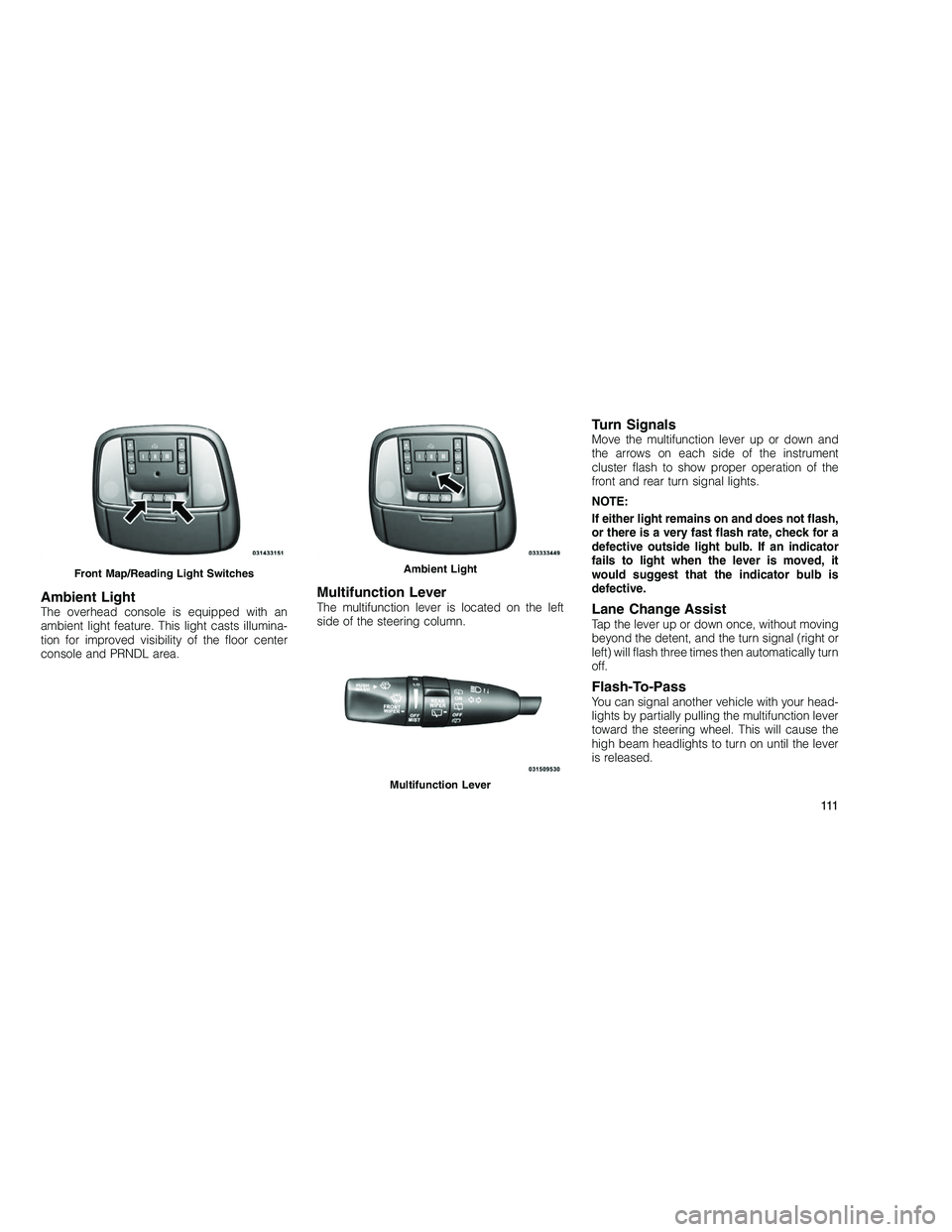
Ambient LightThe overhead console is equipped with an
ambient light feature. This light casts illumina-
tion for improved visibility of the floor center
console and PRNDL area.
Multifunction LeverThe multifunction lever is located on the left
side of the steering column.
Turn SignalsMove the multifunction lever up or down and
the arrows on each side of the instrument
cluster flash to show proper operation of the
front and rear turn signal lights.
NOTE:
If either light remains on and does not flash,
or there is a very fast flash rate, check for a
defective outside light bulb. If an indicator
fails to light when the lever is moved, it
would suggest that the indicator bulb is
defective.
Lane Change AssistTap the lever up or down once, without moving
beyond the detent, and the turn signal (right or
left) will flash three times then automatically turn
off.
Flash-To-PassYou can signal another vehicle with your head-
lights by partially pulling the multifunction lever
toward the steering wheel. This will cause the
high beam headlights to turn on until the lever
is released.
Front Map/Reading Light SwitchesAmbient Light
Multifunction Lever
111
Page 116 of 350
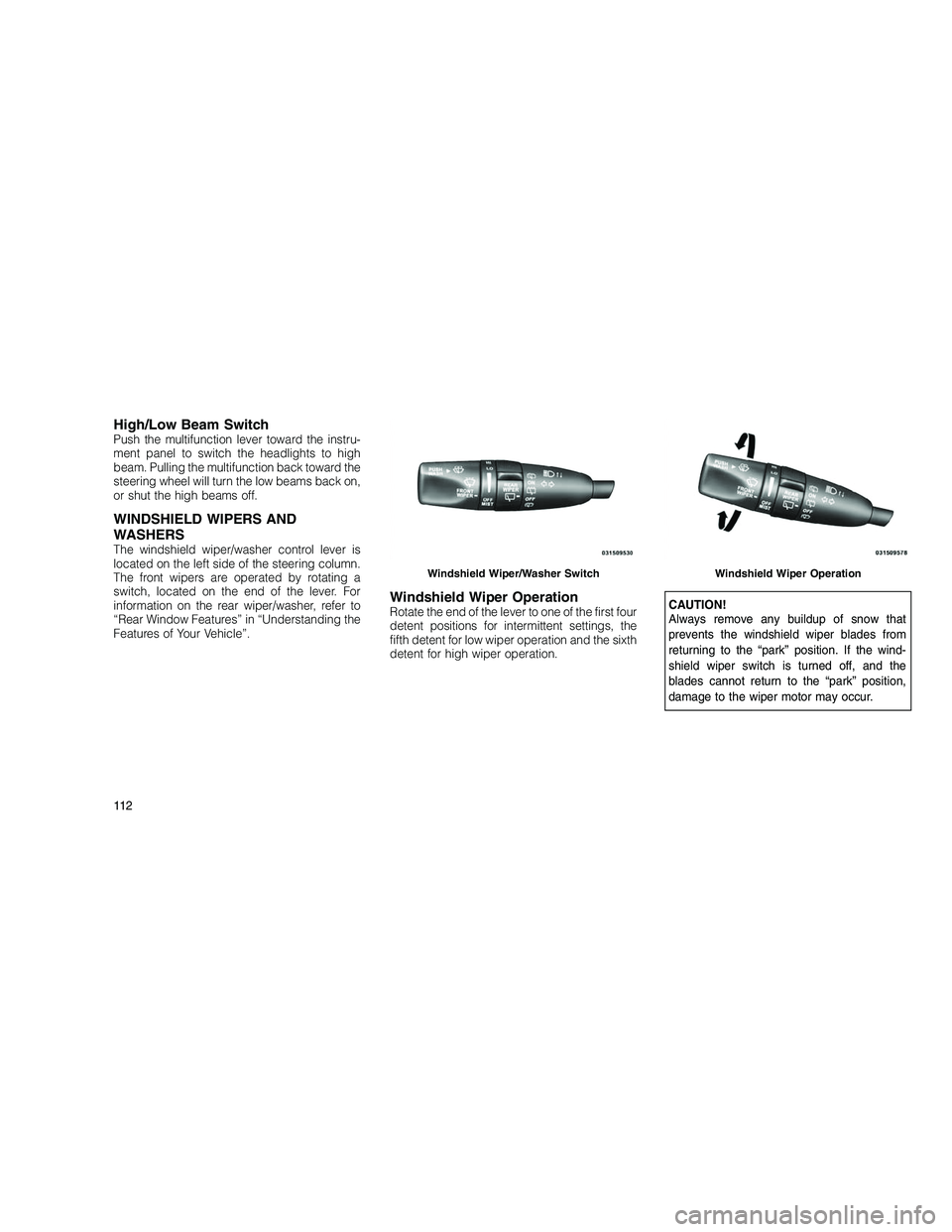
High/Low Beam SwitchPush the multifunction lever toward the instru-
ment panel to switch the headlights to high
beam. Pulling the multifunction back toward the
steering wheel will turn the low beams back on,
or shut the high beams off.
WINDSHIELD WIPERS AND
WASHERS
The windshield wiper/washer control lever is
located on the left side of the steering column.
The front wipers are operated by rotating a
switch, located on the end of the lever. For
information on the rear wiper/washer, refer to
“Rear Window Features” in “Understanding the
Features of Your Vehicle”.
Windshield Wiper OperationRotate the end of the lever to one of the first four
detent positions for intermittent settings, the
fifth detent for low wiper operation and the sixth
detent for high wiper operation.CAUTION!
Always remove any buildup of snow that
prevents the windshield wiper blades from
returning to the “park” position. If the wind-
shield wiper switch is turned off, and the
blades cannot return to the “park” position,
damage to the wiper motor may occur.
Windshield Wiper/Washer SwitchWindshield Wiper Operation
11 2
Page 120 of 350
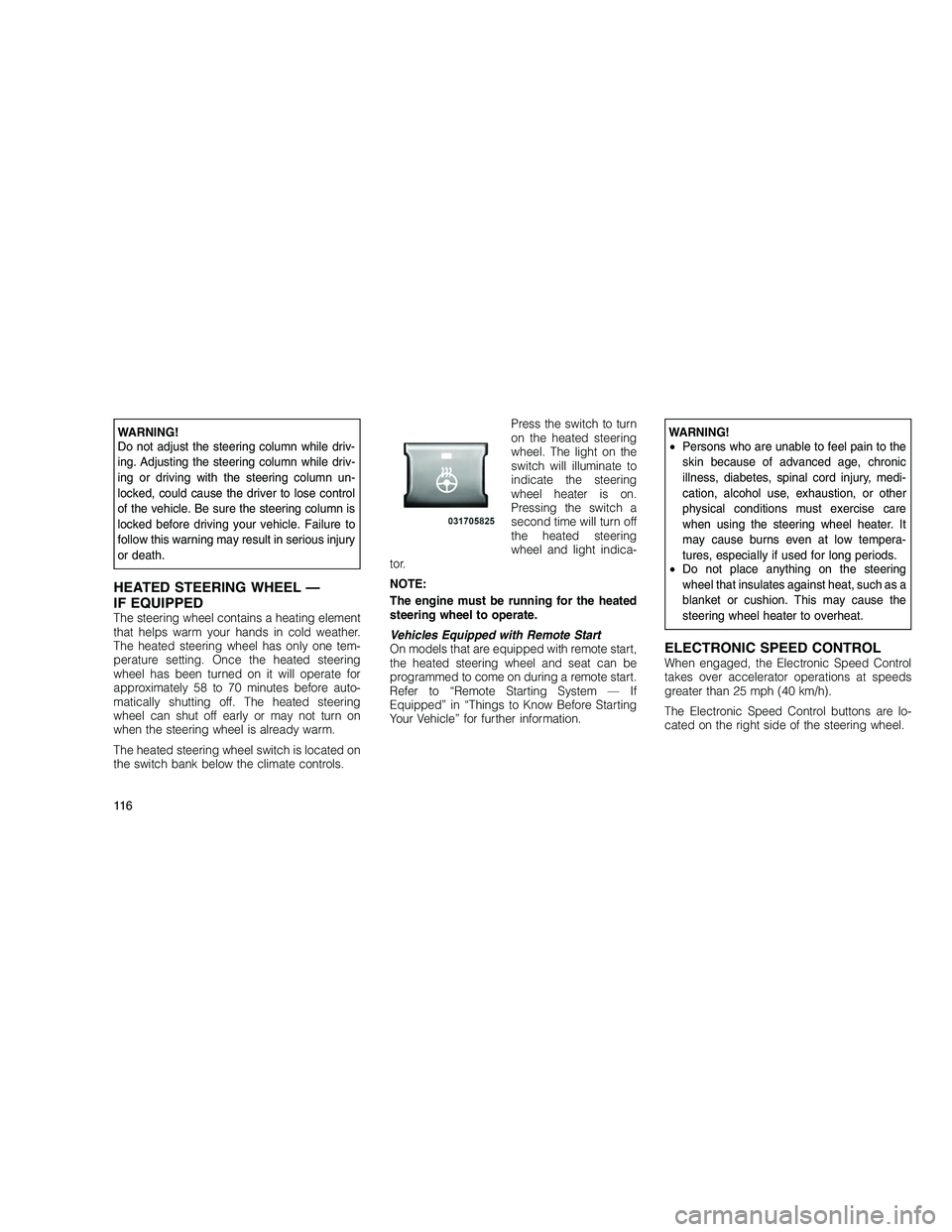
WARNING!
Do not adjust the steering column while driv-
ing. Adjusting the steering column while driv-
ing or driving with the steering column un-
locked, could cause the driver to lose control
of the vehicle. Be sure the steering column is
locked before driving your vehicle. Failure to
follow this warning may result in serious injury
or death.
HEATED STEERING WHEEL —
IF EQUIPPED
The steering wheel contains a heating element
that helps warm your hands in cold weather.
The heated steering wheel has only one tem-
perature setting. Once the heated steering
wheel has been turned on it will operate for
approximately 58 to 70 minutes before auto-
matically shutting off. The heated steering
wheel can shut off early or may not turn on
when the steering wheel is already warm.
The heated steering wheel switch is located on
the switch bank below the climate controls.Press the switch to turn
on the heated steering
wheel. The light on the
switch will illuminate to
indicate the steering
wheel heater is on.
Pressing the switch a
second time will turn off
the heated steering
wheel and light indica-
tor.
NOTE:
The engine must be running for the heated
steering wheel to operate.
Vehicles Equipped with Remote Start
On models that are equipped with remote start,
the heated steering wheel and seat can be
programmed to come on during a remote start.
Refer to “Remote Starting System — If
Equipped” in “Things to Know Before Starting
Your Vehicle” for further information.
WARNING!
• Persons who are unable to feel pain to the
skin because of advanced age, chronic
illness, diabetes, spinal cord injury, medi-
cation, alcohol use, exhaustion, or other
physical conditions must exercise care
when using the steering wheel heater. It
may cause burns even at low tempera-
tures, especially if used for long periods.
• Do not place anything on the steering
wheel that insulates against heat, such as a
blanket or cushion. This may cause the
steering wheel heater to overheat.
ELECTRONIC SPEED CONTROLWhen engaged, the Electronic Speed Control
takes over accelerator operations at speeds
greater than 25 mph (40 km/h).
The Electronic Speed Control buttons are lo-
cated on the right side of the steering wheel.
11 6
Page 121 of 350
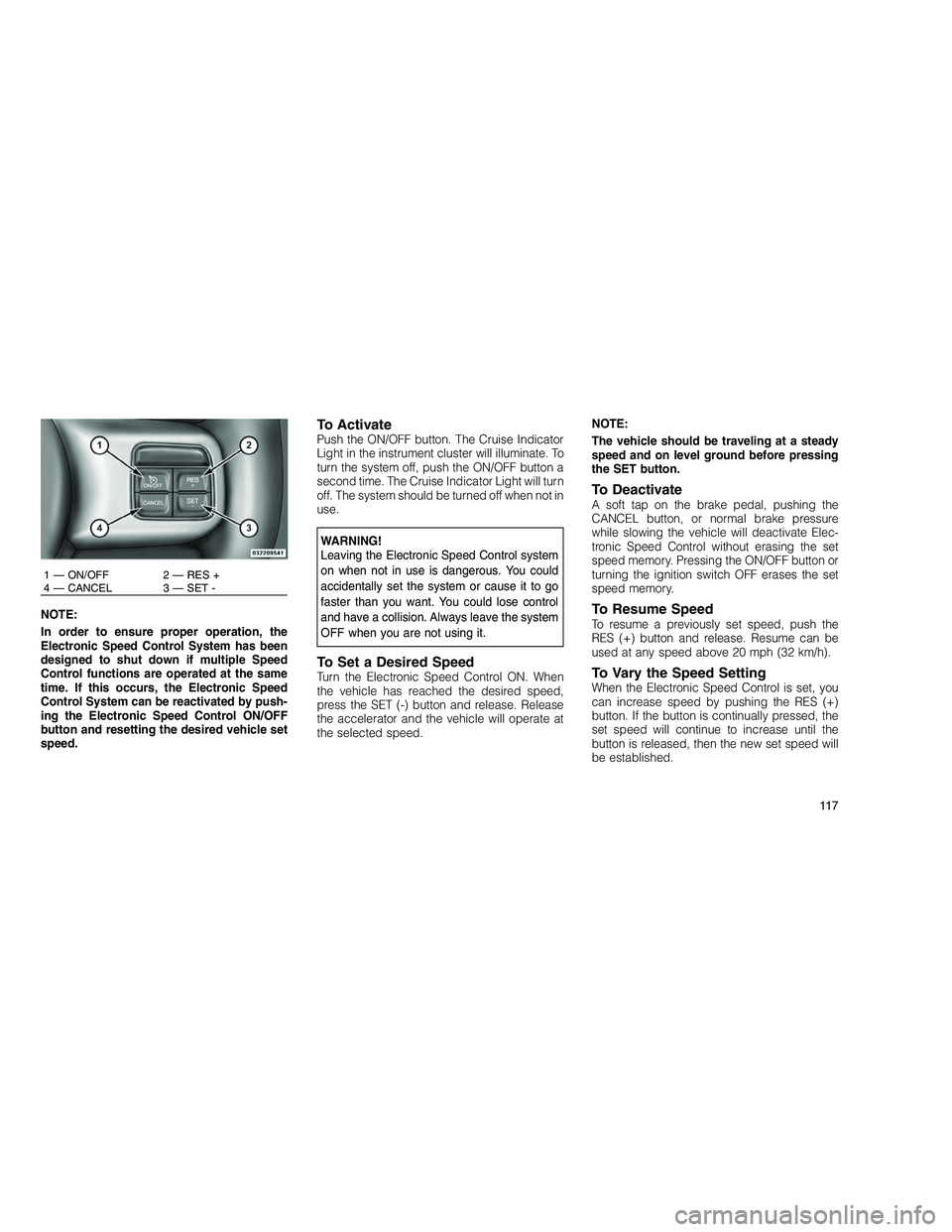
NOTE:
In order to ensure proper operation, the
Electronic Speed Control System has been
designed to shut down if multiple Speed
Control functions are operated at the same
time. If this occurs, the Electronic Speed
Control System can be reactivated by push-
ing the Electronic Speed Control ON/OFF
button and resetting the desired vehicle set
speed.
To ActivatePush the ON/OFF button. The Cruise Indicator
Light in the instrument cluster will illuminate. To
turn the system off, push the ON/OFF button a
second time. The Cruise Indicator Light will turn
off. The system should be turned off when not in
use.
WARNING!
Leaving the Electronic Speed Control system
on when not in use is dangerous. You could
accidentally set the system or cause it to go
faster than you want. You could lose control
and have a collision. Always leave the system
OFF when you are not using it.
To Set a Desired SpeedTurn the Electronic Speed Control ON. When
the vehicle has reached the desired speed,
press the SET (-) button and release. Release
the accelerator and the vehicle will operate at
the selected speed.NOTE:
The vehicle should be traveling at a steady
speed and on level ground before pressing
the SET button.
To DeactivateA soft tap on the brake pedal, pushing the
CANCEL button, or normal brake pressure
while slowing the vehicle will deactivate Elec-
tronic Speed Control without erasing the set
speed memory. Pressing the ON/OFF button or
turning the ignition switch OFF erases the set
speed memory.
To Resume SpeedTo resume a previously set speed, push the
RES (+) button and release. Resume can be
used at any speed above 20 mph (32 km/h).
To Vary the Speed SettingWhen the Electronic Speed Control is set, you
can increase speed by pushing the RES (+)
button. If the button is continually pressed, the
set speed will continue to increase until the
button is released, then the new set speed will
be established.
1 — ON/OFF 2 — RES +
4 — CANCEL 3 — SET -
11 7
Page 122 of 350
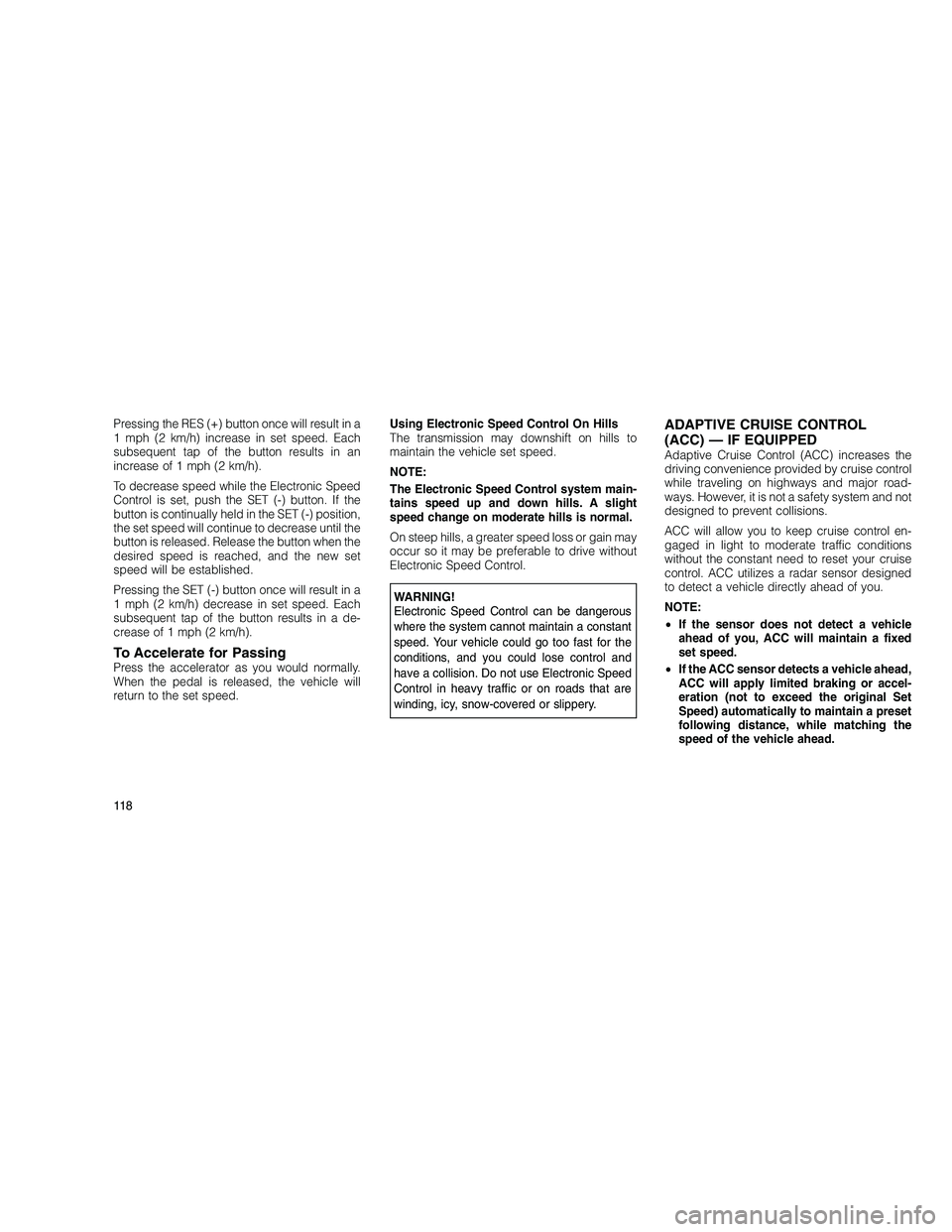
Pressing the RES (+) button once will result in a
1 mph (2 km/h) increase in set speed. Each
subsequent tap of the button results in an
increase of 1 mph (2 km/h).
To decrease speed while the Electronic Speed
Control is set, push the SET (-) button. If the
button is continually held in the SET (-) position,
the set speed will continue to decrease until the
button is released. Release the button when the
desired speed is reached, and the new set
speed will be established.
Pressing the SET (-) button once will result in a
1 mph (2 km/h) decrease in set speed. Each
subsequent tap of the button results in a de-
crease of 1 mph (2 km/h).
To Accelerate for PassingPress the accelerator as you would normally.
When the pedal is released, the vehicle will
return to the set speed.Using Electronic Speed Control On Hills
The transmission may downshift on hills to
maintain the vehicle set speed.
NOTE:
The Electronic Speed Control system main-
tains speed up and down hills. A slight
speed change on moderate hills is normal.
On steep hills, a greater speed loss or gain may
occur so it may be preferable to drive without
Electronic Speed Control.
WARNING!
Electronic Speed Control can be dangerous
where the system cannot maintain a constant
speed. Your vehicle could go too fast for the
conditions, and you could lose control and
have a collision. Do not use Electronic Speed
Control in heavy traffic or on roads that are
winding, icy, snow-covered or slippery.
ADAPTIVE CRUISE CONTROL
(ACC) — IF EQUIPPED
Adaptive Cruise Control (ACC) increases the
driving convenience provided by cruise control
while traveling on highways and major road-
ways. However, it is not a safety system and not
designed to prevent collisions.
ACC will allow you to keep cruise control en-
gaged in light to moderate traffic conditions
without the constant need to reset your cruise
control. ACC utilizes a radar sensor designed
to detect a vehicle directly ahead of you.
NOTE:
•
If the sensor does not detect a vehicle
ahead of you, ACC will maintain a fixed
set speed.
• If the ACC sensor detects a vehicle ahead,
ACC will apply limited braking or accel-
eration (not to exceed the original Set
Speed) automatically to maintain a preset
following distance, while matching the
speed of the vehicle ahead.
11 8